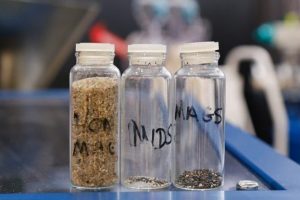An Introduction to Magnetic Properties of Ceramic Minerals: Part One

Since the very first glazed pot was produced thousands of years ago, magnetic minerals and fine iron have been a constant plague on the lives of ceramic producers. In fact, early ceramicists partially adopted the technique of designing ceramics with elaborate, colorful patterns as a way of disguising imperfections caused by this sort of contamination. Over time, though, trends and consumer demand changed, and ceramics designers were overwhelmed with requests for plain white or single-colored ceramic products. As the trends shifted in this way, it became more and more difficult to disguise imperfections within ceramics. Fortunately, ceramic producers discovered magnetic separation was a useful tool to combat these imperfections.

Magnetic separation is a simple and effective way that ceramics producers can identify and remove problematic minerals and fine iron from their processing lines. Many of the raw mineral deposits used in ceramics, including silica sand, ball clay, kaolin, and feldspar, contain problematic magnetic minerals including hematite, chromite, iron-stained quartz, and micas such as muscovite and biotite. In addition to these magnetic minerals, free iron can also enter the process as a result of wear and tear occurring on equipment over time. It is important that ceramics processors understand the magnetic properties and reactions of the minerals they are working with. This will allow them to understand how these magnetic minerals will react within a magnetic field defined under the magnetic separator design process.
The behavior that minerals exhibit in a magnetic field is classified under one of five headings:
• Diamagnetic
• Paramagnetic
• Ferromagnetic
• Anti-ferromagnetic
• Ferrimagnetic
These classifications define whether or not separation is possible using a magnetic separator.

In our next blog, we will examine these five different behaviors that minerals exhibit within a magnetic field and go into more detail about each type of behavior.



